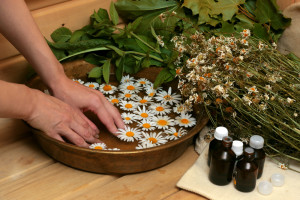Written by Greg Arnold, DC, CSCS. Eighty children with nocturnal enuresis, who had topical chamomile oil applied to the perineal and suprapubic areas every night for eight weeks, decreased their enuresis by a significant 38.5% compared to control.
 When children are unable to control their urination as they get older, that condition is called “enuresis”. In children suffering from enuresis without any other lower urinary tract symptoms and without a history of bladder dysfunction the condition is called “monosymptomatic enuresis” (1). The most common type of enuresis occurs at night (nocturnal enuresis) (2) and involves no physical problem. It can resolve spontaneously but can be very stressful and affect as many as 1 in 5 five-year-old children (3).
When children are unable to control their urination as they get older, that condition is called “enuresis”. In children suffering from enuresis without any other lower urinary tract symptoms and without a history of bladder dysfunction the condition is called “monosymptomatic enuresis” (1). The most common type of enuresis occurs at night (nocturnal enuresis) (2) and involves no physical problem. It can resolve spontaneously but can be very stressful and affect as many as 1 in 5 five-year-old children (3).
Current medical approaches to enuresis include surgery and fluid deprivation (2, 3). Prescription medications are also given (4) but come with side effects that include anxiety, insomnia, and dry mouth (5). As a result, more natural approaches to enuresis are needed.
Now a new study (6) suggests that chamomile oil may be an effective treatment for enuresis. In the study, 80 children (53 boys, 27 girls) aged 8 to 11 with a clinical diagnosis of monosymptomatic enuresis received chamomile oil or placebo each night for 8 weeks. The oil was given topically by the parents, specifically 6 drops applied topically on the perineal and suprapubic area of children one time per night.
The chamomile oil was prepared as dry flowers ground and macerated in water for 24 hours and then decocted for 30 minutes. The resulting extract was then boiled in an oily vehicle to evaporate the water portion (boiling and evaporating method). Patients were evaluated before and after the study regarding the frequency of enuresis.
After 8 weeks, those in the chamomile group saw a 65.3% decrease in enuresis (8.20 to 2.85 instances per day) compared to a 26.8% decrease in the placebo group (8.22 to 6.02 instances per day, p < 0.001). Just as important as the effectiveness of the chamomile was that no adverse events were reported in either group.
When suggesting how Chamomile elicited these healthful effects, the researchers cited the ability of chamomile to decrease the activity of smooth muscle (7, 8). The researchers suggest that chamomile is able to calm the activity of a smooth muscle in the bladder called the detrusor muscle, considered “one of the important causative factors in children with enuresis” (9). They went on to conclude that “the topical use of chamomile oil can decrease the frequency of nocturia in children with monosymptomatic nocturnal or daytime enuresis.”
Source: Sharifi H. Topical use of Matricaria recutita L (Chamomile) Oil in the Treatment of Monosymptomatic Enuresis in Children: A Double-Blind Randomized Controlled Trial. J Evid Based Complementary Altern Med. 2015 Sep 30. pii: 2156587215608989. [Epub ahead of print]
© 2014, Copyright the Authors. Creative Commons Attribution License
Click here to read the full text study.
Posted July 27, 2016.
Greg Arnold is a Chiropractic Physician practicing in Hauppauge, NY. You can contact Dr. Arnold directly by emailing him at PitchingDoc@msn.com or visiting his web site at www.PitchingDoc.com
References:
- World Health Organization. Nonorganic Enuresis. The ICD10 Classification of Mental and Behavioural Disorders: Clinical Descriptions and Diagnostic Guidelines. Geneva, Switzerland: World Health Organization; 1992
- Glazener CMA, Peto RE, Evans JHC. Effects of interventions for the treatment of nocturnal enuresis in children. Qual Saf Health Care. 2003;12:390-394
- Huang T, Shu X, Huang YS, Cheuk DK. Complementary and miscellaneous interventions for nocturnal enuresis in children. Cochrane Database Syst Rev. 2011;(12):CD005230
- Vinchurkar SA, Arankalle DV. Integrating yoga therapy in the management of urinary incontinence: a case report. J Evid Based Complementary Altern Med. 2015;20:154-156
- Ilyas M. Management of nocturnal childhood enuresis: a new challenge. Pediatr Ann. 1996;25:258-264.
- Sharifi H. Topical use of Matricaria recutita L (Chamomile) Oil in the Treatment of Monosymptomatic Enuresis in Children: A Double-Blind Randomized Controlled Trial. J Evid Based Complementary Altern Med. 2015 Sep 30. pii: 2156587215608989. [Epub ahead of print]
- Jarrahi M, Vafaei AA, Taherian AA, Miladi H, Rashidi Pour A. Evaluation of topical Matricaria chamomilla extract activity on linear incisional wound healing in albino rats. Nat Prod Res. 2010;24:697-702
- Maschi O, Cero ED, Galli GV, Caruso D, Bosisio E, Dell’Agli M. Inhibition of human cAMP-phosphodiesterase as a mechanism of the spasmolytic effect of Matricaria recutita L. J Agric Food Chem. 2008;56:5015-5020
- Achterrath-Tuckermann U, Kunde R, Flaskamp E, Isaac O, Thiemer K. Pharmacological investigations with compounds of chamomile. V. Investigations on the spasmolytic effect of compounds of chamomile and Kamillosan on the isolated guinea pig ileum [in German]. Planta Med. 1980;39:38-50
